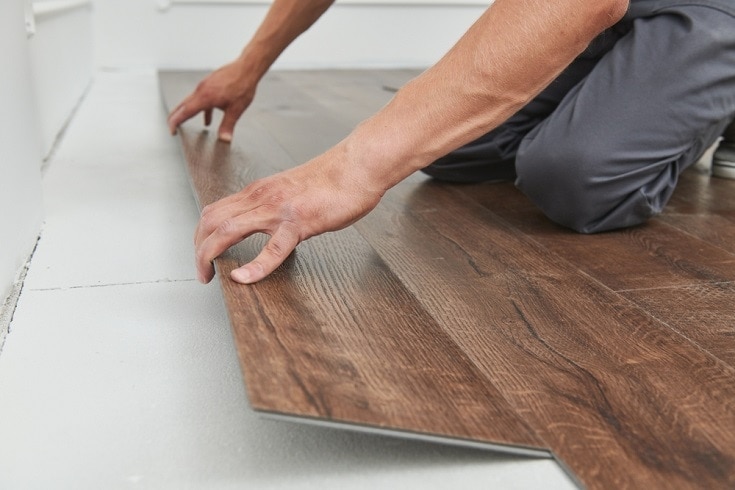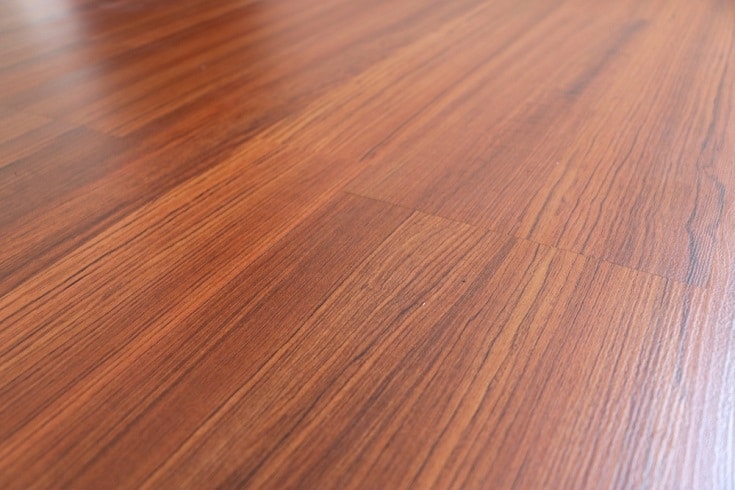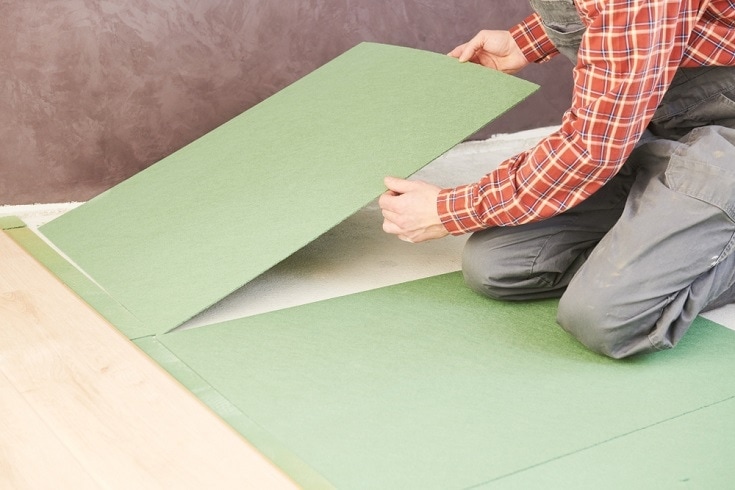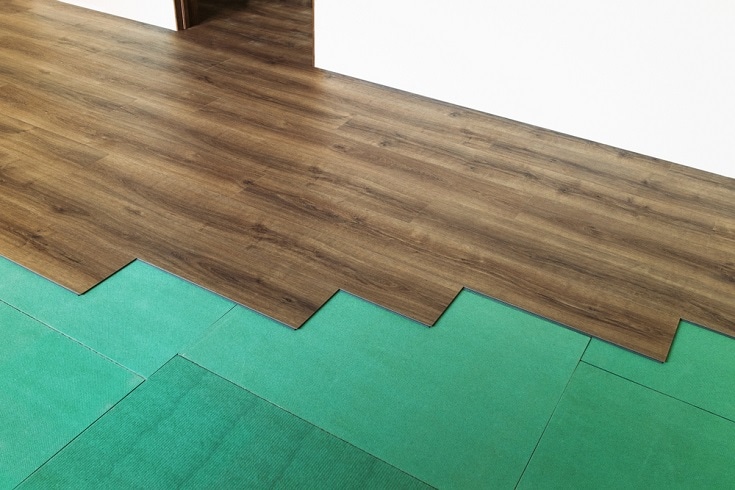Cost to Install Vinyl Plank Flooring (Cost Per Square Foot in 2023)
-
- Last updated:


Vinyl is quickly becoming one of the more popular flooring options available. It is cheaper than traditional options and comes in thousands of styles. You can pick vinyl that looks like a hardwood floor, masonry, or tile. Plank flooring is one of the more popular varieties.
It often looks like hardwood but is much cheaper. However, just because vinyl is cheaper doesn’t mean the cost can’t be substantial. In this article, we’ll look at how much vinyl plank flooring usually costs, including the installation.

Factors that Affect the Cost of Materials
When installing vinyl flooring, the material’s cost is one of the most important factors. The cost of vinyl can vary widely. We’ll take a look at all the factors that determine vinyl’s underlying costs below.
Material
There are a few types of material vinyl can be made from, and some are cheaper than others. However, you shouldn’t choose the cheaper option to save some money. Often, cheaper materials are also not as durable or may require more care. In other words, it may not be that cheap in the long run.
Depending on the material, the vinyl flooring can cost anywhere from $1 a square foot to $6. Inexpensive products usually cost about $1.39, while the best vinyl plank flooring costs about $4.00
Wear Layer
The “wear” layer is the layer on top of the flooring. It’s what you walk on and what takes the most abuse. Different vinyl floorings are added to this layer to help it last longer.
Most entry-level vinyl floorings don’t have anything added, which means the flooring material will matter significantly. Furthermore, this type of flooring usually doesn’t last very long, as it has nothing added to improve its overall durability.
Find a flooring specialist in your area, and get free, no-commitment estimates for your project.Consult a flooring expert


Ceramic beads are added to some vinyl flooring, and a crushed diamond wear layer has been developed. This should be much more durable than most other options, but it is currently difficult to acquire.
Thickness
The thickness of the vinyl directly affects its cost. Thickness is given in “mils.” One mil equals about 0.001 inches. You can find vinyl anywhere from 4 mils to 40 mils thick. The cheapest flooring usually has up to 8 mils, while most have anywhere from 12–20. A few may have as much as 40 mils, but they are typically costly and for industrial use.
Generally, the thicker the flooring, the more expensive it will be. This is simply because more material is involved in making it, so the cost is higher. Usually, a thicker floor will cost anywhere from $4 to $7.

Core Construction
The middle of the vinyl is usually made from stone polymer, wood-plastic, or rigid vinyl. The one you choose depends mainly on your budget and the characteristics you’re looking for.
- Stone polymer — This is the cheapest and most common core. It is made of crushed limestone and is mixed with plastic polymers. It creates a relatively thin but very dense core. It is pretty resistant to wear and tear. Usually, it is used in commercial buildings but can also be used in residences.
- Wood-plastic core — This is made out of wood dust or bamboo, which is then mixed with polymers. It is pliable and thicker than most other options. Therefore, it is a softer flooring prone to dents and damage. Usually, it has the easy-to-install “click” edges. It doesn’t necessarily need glue, but you can glue it down. It usually includes an attached pad and is used in residential settings.
- Solid vinyl cores — This is a relatively new type of vinyl flooring. It is entirely made of vinyl, making it practically waterproof. Most is interlocking and installed similarly to wood-plastic core vinyl. You can glue it down if you need to for whatever reason. The pad is often attached as well.
The Pad
All vinyl flooring needs a pad that goes on the bottom. Often, flooring designed for residential use comes with a pad on it. If it doesn’t, you will need to purchase a pad separately. This usually costs less than $0.30 per square foot of flooring, but it can depend on the material.

However, you will have to pay extra for the installation. Since the pad needs to be attached to the vinyl flooring, it will take more time to install. This will increase the cost of the installation.
The Brand
Often, you’ll be paying extra for the brand name. The cost is usually substantially cheaper when there is a direct sale between the manufacturer and the seller.
Of course, you may be losing brand-specific benefits, like the warranty or customer service. Brand-name flooring may be worth it, depending on your situation and preferences. Look for brands and ways to purchase directly from the manufacturer without a middleman.
Installation Cost
On top of purchasing the flooring, you also need to pay someone to install it unless you decide to go the DIY route. If you plan on installing the flooring, it is not something you need to consider. The installation cost is usually somewhere between $2 to $3 a square foot. For those who charge hourly instead, it will likely be between $30–$50 an hour. Here are some factors that can directly interfere with the cost of the installation.
Time of Year
People tend to renovate their homes in the spring and fall. The exact dates in your area will likely depend on the climate and your exact location. In places with an “on” season, it will likely cost the most right before the season begins.
Time your installation with this in mind if you’re looking for the most savings. Depending on your area and the project size, You can save anywhere from $500 to $700.
Particular Contractor
Usually, the amount of experience a contractor has will affect their prices. However, there are other factors to consider. A company with a large crew will likely charge more, but they can do it faster. “Extras” like insurance and guarantees will cost you more upfront too, but they may save you money in the long run.

Repairing mistakes can be costly. We recommend getting quotes from various contractors. Someone inexperienced without insurance could cost you thousands more after the job is done. Choose someone you can trust to do the job right the first time.
Time Involved
Some types of flooring may take longer to install. For instance, if the flooring does not come with a backing, the contractor will need to install it on-site, raising the prices. Some issues can make the installation take longer than it should, such as repairs that need to be made to your subfloor before the flooring can be installed.
Repairs and Other Setbacks
You’ll also need to consider the repairs and possible setbacks the professionals might encounter during the installation. These are rare but may be more likely to happen if you’re in an older home or one that has been damaged.
If you expect underlying damage, have the contractor evaluate your home for possible problems before you go ahead with installing the flooring. Repairs can cost far more than the actual installation of the flooring and may need a different contractor to take care of them. However, you will need to get them taken care of before you move to install the flooring.

FAQs
Below are some of the most common questions involving the cost of installing vinyl. You may find the answer here if you’re left with any trailing questions.
What is the average cost to install vinyl plank flooring?
For about 200 square feet, you can expect to pay about $1,400. Usually, the cost will go up a bit as your space gets larger since that will require more materials and take more time. Usually, you can expect to pay about $1.50–$2.75 per square foot for the installation, plus the cost of the actual flooring.
You can lower your costs substantially if you decide to install it yourself, which is quite easy with some flooring types. Of course, you will need the required tools, which will also cost you a bit upfront.
How much does Lowes charge to install vinyl planks?
In most areas, Lowes will install your vinyl planks. Usually, the cost is somewhere around $2 a foot, which is about average. This will vary from region to region. It may also depend on the season as well.
Conclusion
The cost of vinyl flooring varies depending on your location. However, you can lower your expenses by purchasing vinyl products in the off-season. Thicker vinyl will cost more, but it’s worthwhile to install more durable flooring that requires less maintenance and fewer repairs. Although a professional installation is pricier, it usually includes a warranty.
Related Reads:
- Cost to Install Carpet (Cost Per Square Foot)
- Cost to Install Hardwood Floors (Cost Per Square Foot)
- 9 DIY Basement Flooring Ideas for Your Home (with Pictures)
Featured Image: Dmitry Kalinovsky, Shutterstock
Contents

